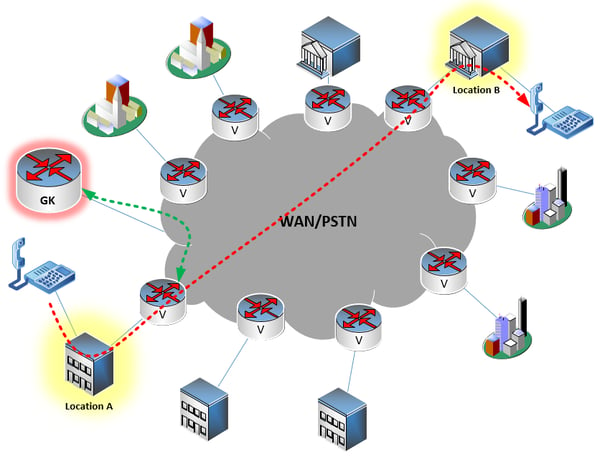Part 2 of 2

When it comes to VoIP signaling, SIP is by far the most widely-used protocol. But, there are other protocols, as well, and being familiar with them is helpful when establishing interoperability between systems or deploying specialized installations. In this article, we’ll discuss the H.323 protocol suite and the media gateway control protocol (MGCP), and look at applications for which they are best suited.
H.323 VoIP protocol suite
The most common VoIP signaling protocol working as an alternative to SIP is H.323. It was developed by the ITU-Telecom Standardization Sector (ITU-T). Although it can be used for voice conversations, it is most often applied today in video conferencing equipment, and leverages the Q.931 standard, which defines legacy ISDN circuits. The original intention was to allow video conferencing systems to use ISDN infrastructure, which seemed to be a very promising technology at the time, although H.323 has since been adapted to run over IP networks, as well.
H.323 is more properly referred to as a system specification or standard that includes various protocols providing multiple services. These protocols are further described below:
H.225.0 Call Signaling – This is the fundamental signaling protocol in the H.323 suite. It is essentially SIP’s counterpart.
H.245 Control Protocol – This protocol describes the messages and procedures used for the exchange of capability information between endpoints, and opens and closes logical channels for voice and video. This is loosely related to SDP as far as functionality goes.
RTP and RTCP – H.323 uses these protocols for the transfer of the media itself, as well as for statistics and control information in much the same way that they operate with SIP.
H.225.0 Registration, Admission and Status (RAS) – This feature is unique to H.323 in that it doesn’t have a counterpart in a SIP environment. Where SIP is flat in its architecture, the H.225.0 RAS protocol provides a hierarchical structure to call signaling. This is especially useful for large enterprises with multiple campuses, locations or branch offices that require a centralized and interconnected telephony network.
RAS use-case
RAS is used between an H.323 endpoint and what is known as a gatekeeper, and is most often employed at H.323 endpoints that function as gateways. An example of where this would be used would be a corporation with multiple nationwide or worldwide locations.
If each location uses a H.323 voice gateway to connect to a centralized network such as a corporate WAN and/or the PSTN, then in order to route calls to all the other locations, the numbering plan of all other locations must be registered with each voice gateway. If a phone at Location A wants to call a phone at Location B, the voice gateway at Location A must know where to find the gateway at Location B so the call can be routed. The administrative overhead of such an arrangement can be vividly seen, especially if you choose to add an additional branch, requiring you to input the proper routing information into each and every voice gateway on your network.
This is where the H.225.0 RAS protocol comes in. In an H.323 architecture, the voice gateways only need to know the location of the H.323 gatekeeper: a device on the network containing the consolidated numbering plan (labeled GK in the following diagram). When a call comes in, the gateways will query the gatekeeper for the IP address of the gateway that services the desired destination number. The gatekeeper will respond with this information, allowing the call to be completed.

With this arrangement, administrators only need to keep the gatekeeper’s information updated, greatly streamlining the process. Additional services can also be enabled on these calls. For example, a gatekeeper will not only inform a gateway of how to get to a particular destination, but it can also employ access control by allowing or denying such a call, depending on how it has been configured.
The function of the gatekeeper is often described as being similar to that of a DNS server, which provides IP addresses for particular domain names.
MGCP
A discussion on VoIP protocols would be incomplete without mentioning Media Gateway Control Protocol (MGCP). Where SIP and H.323 can be used for multiple types of endpoints, MGCP is specifically engineered to control voice gateways. MGCP transfers the intelligence and administrative activities from the voice gateway to the IP PBX.
In a typical SIP or H.323 installation, administrators are required to configure both the IP PBX and the voice gateway individually. MGCP delivers a deeper integration that allows administrators to configure the gateways from the interface of the IP PBX itself. In this way, an MGCP gateway ceases to function independently, and rather is instructed, controlled and operated by the IP PBX in much the same way that an IP phone is configured and controlled.
This not only simplifies administration, but it also results in the centralization of all processing and control activities within the IP PBX. The physical gateway simply becomes an executor device, or an extension of the IP PBX. This ensures compatibility and an even tighter integration of operations and functionalities. Of course, such an application requires that both the gateway and the IP PBX support the MGCP protocol.
Conclusion
Thanks to its phenomenal flexibility and valuable functionality, SIP is the most widely used VoIP signaling protocol for voice and video communications. Nevertheless, understanding alternative protocols like H.323 and MGCP is also beneficial when requiring interoperability between systems or for specialized installations.
Note: This is the second article in a two-part series on VoIP protocols. Click here to read part 1 where we discuss SDP, RTP and RTCP.
You may also like:
Know your protocols: VoIP protocols that work together with SIP
The wonderful world of voice codecs
Demystifying codecs, part 1: Digitizing the human voice









Comments